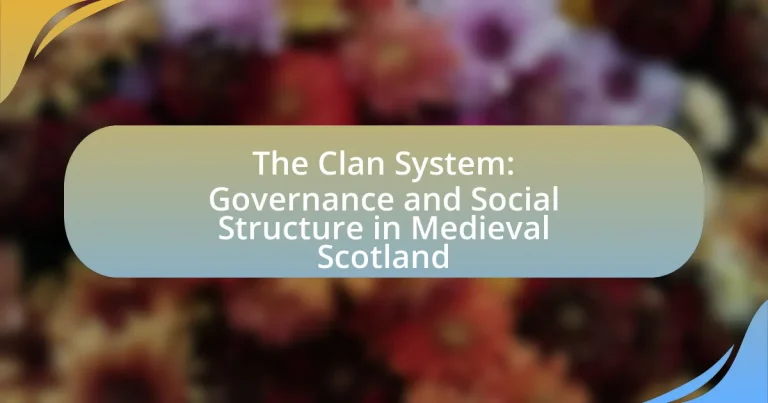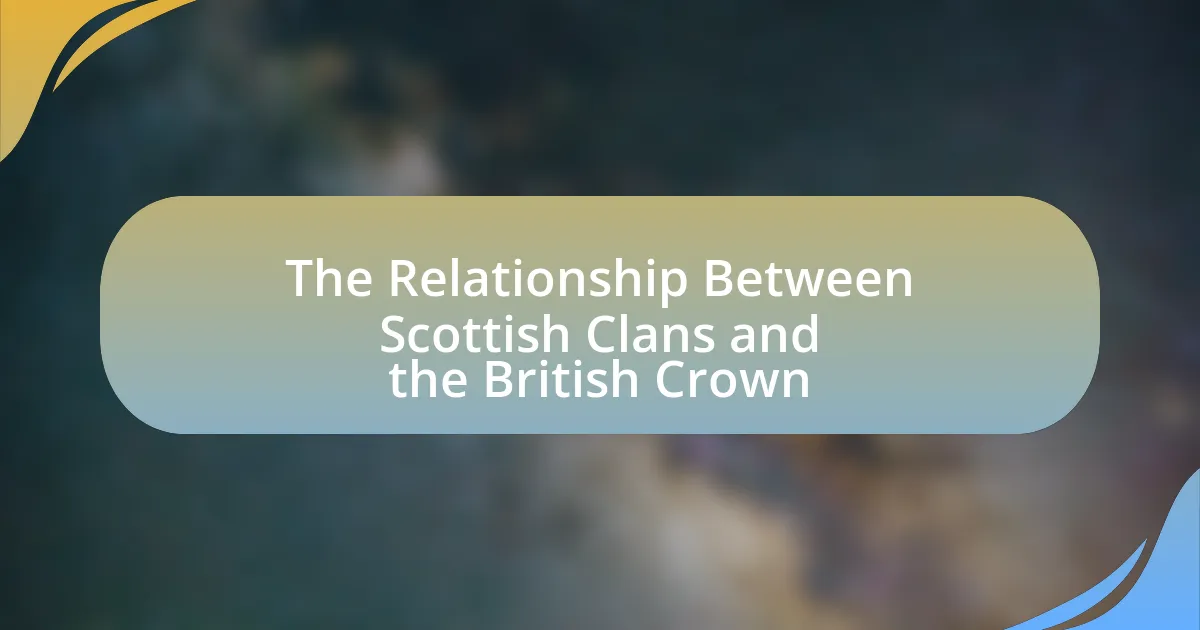The Clan System in Medieval Scotland was a complex social structure centered on kinship and loyalty, where clans, led by chiefs, governed themselves and maintained distinct territories, customs, and laws. This system evolved over time due to various social, political, and economic factors, significantly influenced by historical events such as Viking invasions and the Wars of Scottish Independence. Key components of the clan system included kinship ties, loyalty, leadership, and land ownership, which shaped the governance and social dynamics of clans. The roles of clan members varied, with chiefs, warriors, and commoners fulfilling specific functions essential for the clan’s survival and stability, while cultural practices reinforced clan identity and cohesion. The article explores the implications of clan relationships on broader Scottish society and draws lessons applicable to modern governance and community building.

What is the Clan System in Medieval Scotland?
The Clan System in Medieval Scotland was a social structure based on kinship and loyalty, where clans, or extended family groups, governed themselves under a chief. Each clan had its own territory, customs, and laws, and the chief was responsible for the welfare and protection of clan members. This system was characterized by strong ties of allegiance, often reinforced through marriage and alliances, and played a crucial role in the political landscape of Scotland during the medieval period. Clans often engaged in conflicts with one another, which shaped the historical narrative of Scotland, particularly during the 13th to 16th centuries, as seen in events like the Wars of Scottish Independence.
How did the Clan System develop over time?
The Clan System in Medieval Scotland developed through a combination of social, political, and economic factors. Initially, clans emerged as kinship groups that provided mutual support and protection, often centered around a common ancestor. Over time, these clans evolved into more structured entities, with leaders known as chiefs who wielded authority over their members. The consolidation of power among clans was influenced by territorial disputes, alliances, and the need for defense against external threats, such as Viking invasions and later English encroachments. By the 15th century, the clan system became more formalized, with established laws and customs governing clan behavior, land ownership, and loyalty. This evolution was further solidified by the feudal system, which integrated clans into a broader hierarchy of landholding and governance, ultimately shaping the social structure of Scotland during this period.
What historical events influenced the formation of clans?
The formation of clans in Medieval Scotland was significantly influenced by events such as the Viking invasions, the establishment of feudalism, and the Wars of Scottish Independence. The Viking invasions during the 8th and 9th centuries disrupted existing social structures and led to the consolidation of power among local leaders, fostering clan loyalty as a means of protection and survival. The introduction of feudalism in the 12th century further shaped clan dynamics, as land ownership became tied to loyalty and service to a lord, solidifying clan hierarchies. Additionally, the Wars of Scottish Independence in the late 13th and early 14th centuries galvanized clan identities, as clans united against a common enemy, reinforcing their social cohesion and political significance. These historical events collectively contributed to the emergence and evolution of the clan system in Scotland.
How did geography impact clan development?
Geography significantly influenced clan development in medieval Scotland by determining resource availability, settlement patterns, and social interactions. The rugged terrain and mountainous regions created natural barriers that led to the isolation of clans, fostering distinct identities and cultures. For instance, clans in the Highlands, such as the MacDonalds and Campbells, adapted to their environments by developing unique agricultural practices and social structures suited to their specific landscapes. Additionally, proximity to rivers and coastlines facilitated trade and communication, impacting alliances and conflicts among clans. Historical records indicate that clans often engaged in territorial disputes over fertile land and strategic locations, further shaping their development and governance structures.
What are the key components of the Clan System?
The key components of the Clan System include kinship, loyalty, leadership, and land ownership. Kinship forms the foundation of the clan, as members are often related by blood or marriage, creating a strong sense of identity and belonging. Loyalty is crucial, as clan members are expected to support one another, particularly in times of conflict or need. Leadership is typically provided by a chief, who is responsible for the welfare of the clan and makes decisions regarding governance and defense. Land ownership is significant, as clans often control specific territories, which are vital for their economic sustenance and social structure. These components collectively define the Clan System’s governance and social dynamics in Medieval Scotland.
What roles did clan chiefs play in governance?
Clan chiefs served as the primary leaders and decision-makers within their clans, playing crucial roles in governance by maintaining order, enforcing laws, and representing their clans in external affairs. They were responsible for the administration of justice, managing resources, and leading their members in times of conflict. Historically, clan chiefs held significant power, often acting as both military leaders and political representatives, which was essential for the cohesion and survival of their clans during the turbulent periods of medieval Scotland. Their authority was often legitimized through lineage and tradition, reinforcing their position within the clan system.
How were clans structured socially and politically?
Clans in medieval Scotland were structured both socially and politically around a chief, who held authority and leadership over the clan members. The chief was responsible for the welfare and protection of the clan, and their status was often hereditary, passed down through family lines. Beneath the chief, the clan was organized into various tiers, including sub-chiefs and lesser nobles, who managed specific responsibilities and territories within the clan’s domain.
Socially, clans operated on a kinship basis, where loyalty and support among members were paramount, often reinforced through shared ancestry and communal activities. This kinship fostered a strong sense of identity and belonging, which was crucial for survival in a tumultuous period marked by conflicts and rivalries.
Politically, clans functioned as semi-autonomous units, often engaging in alliances or feuds with other clans, which shaped the broader political landscape of Scotland. The clan system was integral to local governance, with decisions made collectively in gatherings known as ‘clan councils,’ where influential members would deliberate on matters affecting the clan. This structure allowed clans to maintain a degree of independence while also participating in the larger feudal system of Scotland.
What was the significance of kinship in the Clan System?
Kinship was fundamental to the Clan System as it established social cohesion, identity, and loyalty among members. In this system, kinship ties dictated relationships, responsibilities, and alliances, reinforcing the clan’s collective strength and unity. Historical evidence shows that clans were often organized around familial connections, with leaders typically emerging from prominent families, thereby ensuring that governance was closely tied to blood relations. This kinship-based structure facilitated resource sharing, mutual defense, and social support, which were crucial for survival in the often tumultuous environment of medieval Scotland.
How did kinship ties affect loyalty and conflict?
Kinship ties significantly influenced loyalty and conflict within the clan system of medieval Scotland. These ties fostered a strong sense of allegiance among clan members, as familial relationships often dictated social and political alliances. For instance, loyalty to one’s kin was paramount, leading to collective action in defense of family honor and territory, which frequently resulted in conflicts with rival clans. Historical records indicate that feuds, such as the long-standing rivalry between the MacDonalds and the Campbells, were deeply rooted in kinship dynamics, where loyalty to family often escalated into violent confrontations. Thus, kinship not only shaped individual identities but also structured the broader social landscape, intertwining loyalty and conflict in a complex web of relationships.
What were the implications of clan relationships on broader Scottish society?
Clan relationships significantly influenced broader Scottish society by establishing social hierarchies, fostering loyalty, and shaping political alliances. These relationships created a network of obligations and support among clan members, which reinforced social cohesion and identity. For instance, during the 13th and 14th centuries, clans often aligned with or against each other based on shared interests, impacting regional power dynamics and conflicts, such as the Wars of Scottish Independence. The clan system also facilitated the distribution of land and resources, as clan chiefs held authority over their members, which in turn affected agricultural practices and economic stability within their territories. This intricate web of clan interactions ultimately contributed to the formation of a distinct Scottish cultural identity, as clans became central to the social fabric of Scotland.

How did the Clan System govern its members?
The Clan System governed its members through a hierarchical structure led by a chief who held authority over the clan’s affairs. This governance was characterized by loyalty, kinship ties, and a shared identity among clan members, which fostered a sense of belonging and mutual support. The chief was responsible for making decisions, resolving disputes, and ensuring the welfare of the clan, while members were expected to adhere to the clan’s customs and support one another in times of conflict. Historical evidence shows that clans operated under a system of mutual obligation, where members provided military support to the chief and, in return, received protection and resources, reinforcing the clan’s social cohesion and stability.
What were the governing principles of clans?
The governing principles of clans in medieval Scotland were primarily based on kinship, loyalty, and collective responsibility. Clans operated under a system where the chief held authority, and decisions were made collectively, reflecting the interests of the clan members. This structure emphasized the importance of familial ties, with members expected to support one another in times of conflict and cooperation. Historical records indicate that clan governance was often formalized through customs and traditions, which reinforced social cohesion and a shared identity among members.
How did clans enforce laws and customs?
Clans enforced laws and customs through a combination of social pressure, communal consensus, and the authority of clan leaders. Clan leaders, often referred to as chiefs, held significant power and were responsible for maintaining order and ensuring adherence to established traditions. They would convene gatherings, known as clan moots, where disputes were settled, and decisions were made collectively, reinforcing the clan’s legal framework. Additionally, the threat of social ostracism or loss of status acted as a deterrent against violations of clan laws, as loyalty and reputation were paramount in clan society. Historical records indicate that these mechanisms were effective in maintaining social cohesion and order within clans, as evidenced by the structured governance observed in various clan conflicts and resolutions documented in Scottish history.
What role did assemblies play in clan governance?
Assemblies played a crucial role in clan governance by serving as decision-making bodies where clan members gathered to discuss and resolve important issues. These assemblies, often referred to as “moots,” facilitated consensus-building among clan leaders and members, allowing for collective decision-making on matters such as land disputes, alliances, and leadership succession. Historical records indicate that assemblies were integral to maintaining social order and cohesion within clans, as they provided a platform for dialogue and negotiation, thereby reinforcing the clan’s social structure and governance.
How did clan governance compare to other systems in medieval Scotland?
Clan governance in medieval Scotland was characterized by a decentralized and kin-based structure, contrasting sharply with the more centralized feudal systems that dominated other regions. Clans operated under a chief who held authority based on lineage and loyalty, fostering strong familial ties and communal responsibility, while feudal systems relied on a hierarchy of lords and vassals with obligations defined by land ownership and military service. Historical records indicate that clan leaders, such as the MacDonalds and Campbells, wielded significant local power, often resolving disputes and managing resources independently of the crown, which was less common in feudal systems where the king maintained direct control over land and governance. This clan-based approach allowed for greater adaptability and resilience in the face of external threats, such as Viking invasions, compared to the rigid structures of feudalism that struggled to respond effectively to such challenges.
What were the differences between clan governance and feudal systems?
Clan governance and feudal systems differ primarily in their structure and authority. Clan governance is characterized by a kinship-based system where leadership is often hereditary and decisions are made collectively by clan members, emphasizing loyalty and familial ties. In contrast, feudal systems are hierarchical, with a clear chain of command where land is held in exchange for service, and power is concentrated in the hands of a few lords who govern vassals.
In clan governance, the chief holds authority but is expected to act in the best interest of the clan, while in feudal systems, lords have significant control over their vassals, often enforcing their will through military power. Historical evidence shows that clans operated on mutual support and shared resources, whereas feudalism relied on contractual obligations and land tenure, as seen in medieval Europe where lords granted land to vassals in exchange for military service.
How did clans interact with the Scottish monarchy?
Clans interacted with the Scottish monarchy primarily through a system of loyalty and feudal obligations. Clans pledged allegiance to the monarchy in exchange for protection and land rights, which solidified their status and power within the kingdom. Historical records indicate that during the 13th and 14th centuries, clans such as the MacDonalds and the Campbells played significant roles in supporting monarchs like Robert the Bruce, especially during conflicts such as the Wars of Scottish Independence. This relationship was often characterized by a balance of power, where the monarchy relied on clan leaders to maintain order and loyalty among their followers, while clans sought royal favor to enhance their influence and resources.

What social structures existed within the Clan System?
The Clan System in Medieval Scotland featured a hierarchical social structure primarily organized around kinship and loyalty. At the top of this hierarchy was the clan chief, who held authority over the clan members and was responsible for their welfare and protection. Below the chief were the nobles and warriors, who served as the chief’s retainers and were tasked with defending the clan’s territory. The common clansmen, who made up the majority of the clan, engaged in agriculture and other trades, contributing to the clan’s economy. This structure was reinforced by a strong sense of loyalty and obligation among members, often encapsulated in the concept of “clan,” which emphasized familial ties and collective identity. Historical records indicate that these social structures were essential for maintaining order and unity within clans, particularly during conflicts with rival clans.
What roles did different members of a clan fulfill?
In a clan, different members fulfilled specific roles essential for governance and social structure. The chief led the clan, making decisions and representing the clan in external matters. The clan council, composed of senior members, advised the chief and helped in decision-making. Warriors defended the clan’s territory and engaged in battles, while the common members, including farmers and craftsmen, provided resources and labor for the clan’s sustenance. Additionally, women played crucial roles in managing households and maintaining social cohesion. This division of roles ensured the clan’s survival and stability in medieval Scotland.
How did the roles of warriors and commoners differ?
The roles of warriors and commoners in medieval Scotland were distinctly different, with warriors serving as the military elite responsible for defense and leadership, while commoners engaged in agriculture and trade. Warriors, often from noble families, were trained in combat and held land granted by their clan chiefs, which allowed them to maintain their status and fulfill their duty to protect the clan. In contrast, commoners, who made up the majority of the population, worked the land, produced goods, and supported the clan’s economy, but had limited political power and social mobility. This division was essential for the clan system’s governance, as warriors provided military strength while commoners ensured the clan’s sustenance and stability.
What was the importance of women in clan society?
Women played a crucial role in clan society by serving as key figures in social cohesion, lineage continuity, and economic stability. Their importance is evident in their responsibilities for managing household affairs, which included the upbringing of children and the preservation of cultural traditions. Additionally, women often held significant influence in clan politics, particularly through marriage alliances that strengthened ties between clans. Historical records indicate that women could inherit land and titles, thereby contributing to the clan’s wealth and status. This multifaceted role underscores the integral position women occupied within the clan system, shaping both familial and communal dynamics in medieval Scotland.
How did clan identity shape social interactions?
Clan identity significantly shaped social interactions by establishing a framework of loyalty, kinship, and mutual support among members. This identity fostered strong bonds within the clan, leading to cooperative behaviors in activities such as farming, defense, and trade. Historical evidence shows that clan members often prioritized their clan’s interests over individual desires, which reinforced social cohesion and collective decision-making. For instance, during conflicts, clans would unite to defend their territory, demonstrating how clan identity influenced alliances and enmities with other groups. Additionally, social gatherings and rituals, such as clan feasts and gatherings, further solidified these relationships, creating a sense of belonging and shared purpose among clan members.
What were the cultural practices that reinforced clan identity?
Cultural practices that reinforced clan identity in medieval Scotland included kinship ties, shared rituals, and collective storytelling. Kinship ties were emphasized through the practice of clan gatherings, where members would come together to celebrate their lineage and strengthen familial bonds. Shared rituals, such as traditional ceremonies and feasts, fostered a sense of belonging and unity among clan members. Collective storytelling, often involving the recounting of clan history and heroic deeds, served to instill pride and reinforce the clan’s identity. These practices were crucial in maintaining social cohesion and a distinct cultural identity within the clan system.
How did clan rivalries influence social dynamics?
Clan rivalries significantly influenced social dynamics by creating a framework of loyalty and conflict that shaped community interactions. These rivalries often dictated alliances and enmities, leading to a social structure where kinship ties were paramount. For instance, during the 14th century, the feud between the MacDonald and Campbell clans exemplified how such rivalries could lead to violent confrontations, impacting trade, land ownership, and even political power. The necessity for clans to defend their honor and territory fostered a culture of solidarity within clans, while simultaneously creating divisions between them, which affected social cohesion and governance in medieval Scotland.
What lessons can be learned from the Clan System in Medieval Scotland?
The Clan System in Medieval Scotland teaches the importance of loyalty, kinship, and social cohesion in governance. Clans operated as extended family units, fostering strong bonds that ensured mutual support and protection among members. This structure facilitated collective decision-making and resource sharing, which were crucial for survival in a challenging environment. Historical evidence shows that clans often rallied together during conflicts, demonstrating the effectiveness of unity in achieving common goals. Additionally, the clan system highlights the significance of leadership, as chieftains were responsible for the welfare of their members, illustrating the role of accountability in governance.
How can modern societies apply principles from the Clan System?
Modern societies can apply principles from the Clan System by fostering strong community ties and promoting collective responsibility. The Clan System emphasized loyalty, mutual support, and shared identity among members, which can enhance social cohesion today. For instance, community organizations can adopt clan-like structures to encourage collaboration and resource sharing, similar to how clans provided protection and support to their members in medieval Scotland. Historical evidence shows that clans operated effectively through kinship bonds and collective decision-making, which can inspire modern governance models that prioritize community engagement and participatory leadership.
What are the best practices for fostering community and governance today?
Best practices for fostering community and governance today include promoting inclusivity, encouraging participation, and leveraging technology for communication. Inclusivity ensures diverse voices are heard, which strengthens community ties and governance structures. Encouraging participation through regular meetings and feedback mechanisms allows community members to engage actively in decision-making processes. Leveraging technology, such as social media and online platforms, facilitates communication and collaboration, making it easier for communities to organize and share information. These practices are supported by studies showing that inclusive governance leads to higher satisfaction and trust among community members, ultimately resulting in more effective governance.





